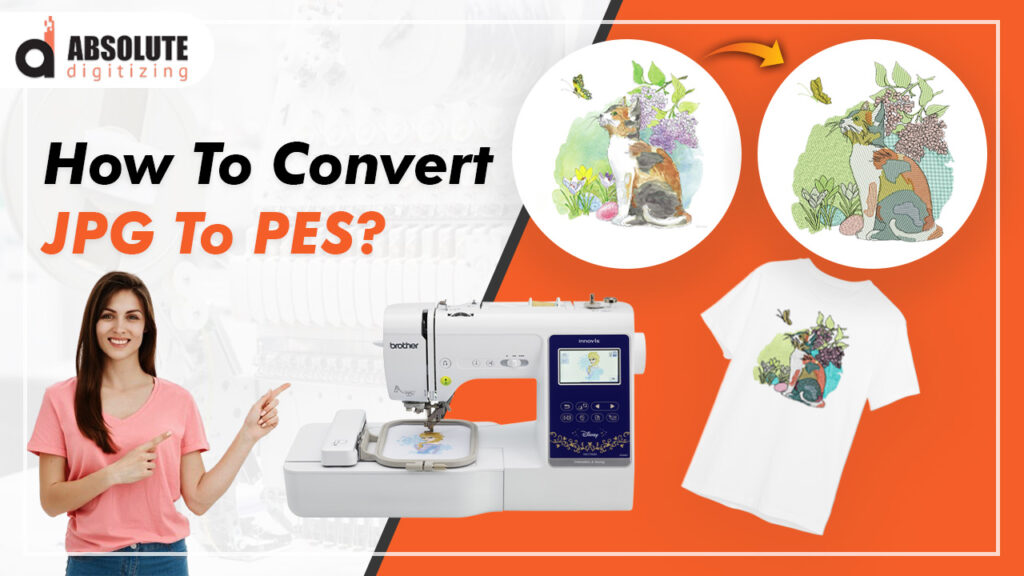Introduction
Embroidering a logo or artwork onto fabric adds a professional, personalized touch to everything from apparel to accessories, and Brother embroidery machines make it easy to achieve stunning results. However, these machines require PES files to interpret stitch instructions accurately, so transforming a JPG image into this format is a critical step. Whether you’re a beginner crafting custom gifts, a business owner branding merchandise, or a hobbyist exploring creative designs, you can achieve professional-quality results with the right approach. In this guide, we’ll show you how to convert JPG to PES for embroidery like a professional, using easy methods and expert tips to ensure flawless designs.
Why Convert JPG to PES?
JPG images are raster-based, meaning they’re made of pixels that can blur or distort when scaled. PES files, specific to Brother and Babylock machines, are vector-like, providing precise stitch instructions for clean, scalable embroidery. Converting JPG to PES ensures compatibility with your Brother machine, prevents stitching errors, and delivers vibrant, durable designs on fabrics like cotton, denim, or polyester. This process is essential for creating professional-looking embroidery for branding, personalization, or creative projects, saving time and ensuring consistency.
Understanding the Conversion Process
Converting a JPG to PES involves digitizing, where software or services analyze the image’s shapes, colors, and details to create a stitch file. The process traces edges, assigns thread colors, and optimizes settings for your fabric and machine. A well-digitized PES file ensures smooth stitching without issues like puckering or thread breaks. With user-friendly tools or professional services, you can achieve professional results quickly, even if you’re new to embroidery.
Method 1: Use Brother PE-Design Software
Brother PE-Design is a dedicated software for Brother machines, offering advanced tools for professional-grade JPG to PES conversion.
Steps to Convert with PE-Design
- Install the Software: Download Brother PE-Design from the official Brother website and install it. It’s available for purchase or trial.
- Import the JPG: Open the software, go to “File” > “Import,” and load your JPG image. Resize it to fit your machine’s hoop (e.g., 4×4 or 5×7 inches).
- Auto-Digitize: Use the “Auto Punch” tool to trace the image’s shapes and colors, creating a stitch pattern.
- Refine the Design: Simplify colors using the color palette tool and assign thread colors from Brother’s library. Choose satin stitches for outlines or fill stitches for solid areas.
- Optimize Settings: Adjust stitch density and underlay to suit your fabric, preventing issues like puckering.
- Save as PES: Go to “File” > “Save As,” select PES format, transfer to your Brother machine via USB, and test on scrap fabric.
PE-Design delivers precise, professional results tailored for Brother machines.
Method 2: Use Embrilliance Essentials
Embrilliance Essentials is an affordable, user-friendly software that supports PES output, making it ideal for beginners and professionals seeking quality conversions.
Steps to Convert with Embrilliance
- Install Embrilliance: Download Embrilliance Essentials from its official website and install it. A free trial is available.
- Import the JPG: Launch the software and import your JPG via “Insert Design” or drag-and-drop. Scale to your hoop size.
- Auto-Digitize: Use the “Auto Digitize” feature to trace the image. Select settings for logos or photos based on your JPG.
- Edit the Design: Manually refine paths, reduce colors to 6–12, and apply satin or fill stitches for professional results.
- Set Parameters: Customize density, pull compensation, and underlay for your fabric type.
- Export as PES: Save the file as PES under “File” > “Save As,” transfer to your machine, and run a test stitch.
Embrilliance’s intuitive tools make professional conversions accessible.
Method 3: Use Free Tools Like Ink/Stitch
Ink/Stitch, a free plugin for the open-source Inkscape software, offers a cost-free way to convert JPGs to PES files with professional accuracy.
Steps to Convert with Ink/Stitch
- Install Inkscape and Ink/Stitch: Download Inkscape from its website and add the Ink/Stitch plugin.
- Import the JPG: Open Inkscape, import your JPG, and use “Trace Bitmap” to create a vector version.
- Digitize the Design: Apply Ink/Stitch tools to add satin or fill stitches and assign colors, optimizing for your Brother machine.
- Preview and Edit: Use the stitch preview to check accuracy and adjust density or spacing.
- Export as PES: Select “Embroider” from extensions and choose PES format.
- Test the File: Transfer to your Brother machine via USB and embroider a sample.
Ink/Stitch requires practice but delivers professional results for free.
Method 4: Hire Professional Digitizing Services
Professional digitizing services provide high-quality PES files with minimal effort, perfect for complex designs or tight deadlines.
Steps to Use a Professional Service
- Choose a Trusted Provider: Select a service like MySewnet or an Etsy digitizer with strong reviews and experience with PES files.
- Upload Your JPG: Submit your JPG image via the provider’s website or email, specifying PES as the output format.
- Provide Machine Details: Indicate your Brother model (e.g., PE800) and hoop size.
- Receive the File: The service will email the digitized PES file, typically within 24–48 hours.
- Test Before Stitching: Stitch the file on scrap fabric to ensure professional quality.
Professional services are ideal for flawless, time-saving results.
Tips for Professional JPG to PES Conversion
To achieve pro-level PES files, follow these tips:
- Use High-Resolution JPGs: Start with images of at least 300 DPI to capture details and avoid pixelated stitches.
- Simplify Designs: Reduce colors and remove intricate details that don’t translate well to embroidery.
- Match Thread Colors: Use Brother thread charts for accurate color selection.
- Test on Fabric: Always run a test stitch on material similar to your project.
- Check Hoop Size: Ensure the design fits your machine’s hoop to avoid resizing issues.
These practices ensure clean, vibrant embroidery.
Common Challenges and Solutions
Converting JPG to PES can have hurdles, but they’re manageable:
- Low-Quality Images: Blurry JPGs lead to poor stitches. Enhance images in Canva or GIMP before digitizing.
- Complex Designs: Overly detailed designs may not stitch well. Simplify colors and shapes during digitizing.
- Stitch Distortion: Adjust pull compensation for stretchy fabrics to maintain design integrity.
- File Compatibility: Ensure the PES version matches your Brother model; older machines may need legacy formats.
Testing and tweaking resolve most issues quickly.
Tools to Enhance Your Workflow
Boost your digitizing with these tools:
- Image Editors: GIMP or Canva to preprocess JPGs for clarity.
- USB Drives: For transferring PES files to your Brother machine.
- Stabilizers: Cut-away for stretchy fabrics or tear-away for woven materials.
- Tutorials: YouTube or Reddit’s r/Embroidery for Brother-specific tips.
These tools streamline the conversion process.
When to Outsource Conversion
For complex logos or time-sensitive projects, outsource to services like MySewnet or Etsy digitizers. They deliver professional PES files optimized for Brother machines, often in 24 hours. Choose providers with strong portfolios and confirm they support PES. Outsourcing is perfect for beginners or high-volume production.
Conclusion
Converting JPG to PES for embroidery like a professional is achievable with tools like Brother PE-Design, Embrilliance, Ink/Stitch, or professional services. Start with high-resolution images, simplify designs, and test files to ensure flawless results on your Brother machine. These methods make it easy to create vibrant, durable embroidery for personal or business use. Dive into converting JPG to PES for embroidery today and craft designs that look polished and professional with ease.


